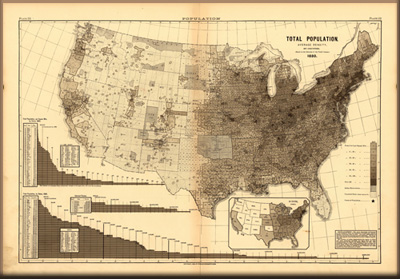
America’s Urban Transition
The Urban Transition Historical GIS Project is directed by John Logan, Professor of Sociology at Brown University. It uses historical census data to document the state of U.S. cities from the end of the 19th Century into the early 20th Century. These were the decades of America’s urban transition, fed by rapid growth of industry and large scale immigration from Eastern and Southern Europe that was directed primarily into cities. In 1880 nearly half of total employment was in agriculture, but this share dropped to about 25% by 1920, and by this time about half of the population lived in urban areas.
"Within the span of a few decades from the late 19th to the early 20th century, the United States was transformed from a predominately rural agrarian society to an industrial economy centered in large metropolitan cities … The decades surrounding 1900 were not only the age of industrialization in the United States, but were also the age of urbanization and immigration. The 1880s were the first decade in American history, with the exception of the Civil War decade, when the urban population increased more than the rural population (in absolute numbers)." Charles Hirschman and Elizabeth Mogford (2009) “Immigration and the American industrial revolution from 1880 to 1920” Social Science Research 38:897-920.
This webpage is a first step toward wider dissemination of research materials from the project. It establishes a baseline for studies of urban growth, spatial structure, and the incorporation of new groups of immigrants and minorities into cities in this period. It takes advantage of a unique data resource, the full transcription of the 1880 Census of Population created by the Church of Jesus Christ of Latter-day Saints and made widely accessible through the North Atlantic Population Project at the Minnesota Population Center.
As the population density map shows, in 1880 the American population was very heavily concentrated on the Northeastern Seaboard. But there were already patches of dense settlement in the Midwest, and the growth of cities like Chicago and Cleveland was already reshaping the urban hierarchy.
Population map of the U.S. in 1880, showing the density of settlement by county across the country.
Click on this map for higher resolution.
With support from National Science Foundation and National Institutes of Health, Dr. Logan and his research team selected 39 major cities for intensive analysis. These cities were mapped and data for all residents were geocoded at the address level. Our web-based GIS system provides interactive access to these data, showing aggregated data for all counties in the U.S. in 1880, and for enumeration districts (EDs), street segments, and buildings in the 39 cities. If you click on a building, the system will display a list of up to ten occupants with their names and other essential information about them.
As additional data resources are becoming available, the Urban Transition HGIS has expanded to include several additional activities. These include:
Philadelphia, 1850-1900. John Logan and Ben Bellman have retrieved the original census data from the Philadelphia Social History Project, with information on block-and-a-half areas of Philadelphia from 1850 to 1880. These data are now in a current GIS system, which they have analyzed in conjunction with the 1880 and 1900 census.
Northern Cities 1900-1930. A team including Allison Shertzer and Randy Walsh (University of Pittsburgh) and John Logan have mapped EDs for ten major Northern cities in each decade 1900-1930, complementing the 1880 maps. This project adds aggregate data for 100% of residents in each year showing the persons’ race, place of birth, and parent’s place of birth.
Segregation Trajectories 1900-1940. The research team has developed resources to conduct analyses of segregation at multiple spatial scales using non-mapped spatial data from the 100% microdata now available from the Minnesota Population Center. John Logan, Ben Bellman, and Elisabeta Minca have prepared a working paper analyzing trajectories of racial segregation for 134 cities over a 40-year period. Measures of segregation for these cities are now available for download.
Map and Data Resources. While mapping of the largest 69 cities in the U.S. in 1930 and 1940 is continuing, we can now make public a “beta” version of historical GIS maps for some cities. These include the street grid, ED boundaries, and ward boundaries in both years. We have also completed development of the Urban Transition Geographic Reference File (GRF). The purpose of the GRF is to facilitate spatially informed analysis of the 100% microdata that have now been made public by the Minnesota Population Center for each decade 1900-1940. The GRF includes geographic variables that we have cleaned or created for every resident and household in 191 cities in each of these decades. It includes the ward, ED, block (in 1930), house number, and street name for every household, plus a dwelling, household, and person number. It also includes the MPCID, which is an identification number that can be used to link directly to the IPUMS 100% microdata. After merging, researchers will be able to create many kinds of population variables at multiple spatial scales for any city or year.
Linking New Yorkers over Decades. In 1998 Dr. Logan initiated a project to link records of residents of New York City and Chicago, tracing people (and in many cases their parents) backwards in time from 1920 to 1880. The current project webpage displays results from the pilot project in New York. Backwards linkage for the full samples has been completed, and plans are underway to track the same people forwards in time to 1930 and 1940.
